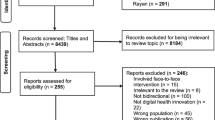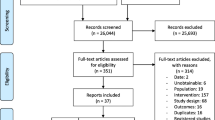Abstract
Technology is increasingly used as a method to engage young people in health issues. This review aimed to assess the effectiveness of technology interventions in preventing and reducing substance use and risky sexual health behaviours in young people. The following databases were searched via Ovid: Psychinfo, Medline, Embase. Studies were systematically screened by title, abstract and 2 reviewers assessed the full papers and discrepancies discussed. Inclusion criteria: young people (aged 12–25 years) that constituted at least 50 % of the population; any technological component including telecommunication, computer and internet that constituted at least 50 % of the intervention; any sexual health or substance use outcome; studies meeting evidence level one-four. 1603 papers were identified by the original search. Of these, 30 were included in the review. The majority of studies showed positive intervention effects, however, most targeted educated young people, such as university students. Additionally, the outcome measures were often psychological determinants of behaviour rather than actual behaviours. Technology has a significant role to play in this field. The review identifies components of effective interventions for young people. However more research is required to target vulnerable populations in order reduce inequalities. Studies are required that involve a wider variety of participants with behavioural outcomes.
Similar content being viewed by others
References
Horwitz LI, Detsky AS. Physician communication in the 21st century to talk or to text? JAMA. 2011. doi:10.1001/jama.2011.324.
Roberto AJ, Zimmerman RS, Carlyle KE, Abner EL. A computer-based approach to preventing pregnancy, STD, and HIV in rural adolescents. J Heal Commun. 2007;12:53–76.
NHS Coventry. App helps residents get the right sexual health service. 2011. http://www.coventry.nhs.uk/YourHealth/SexualHealth/App. Accessed 31 Jan13.
NHS Gloucestershire. Stop Smoking i Phone App. Retrieved from http://www.nhsglos.nhs.uk/your-health/health-topic/smoking/stop-smoking/. 2011. Accessed 31 Jan13.
Meier ST. An exploratory study of a computer-assisted alcohol education program. Comput in Hum Serv. 1988;3:111–121
Barbey MA. Switzerland’s videotex computer sex education programme. Plan Parent Eur. 1991;20:22–3.
Lomba L, Apóstolo J, Mendes F. Drugs and alcohol consumption and sexual behaviours in night recreational settings in Portugal. Adicciones. 2009;21:309–26.
Bailey JV, Murray E, Rait G, Mercer CH, Morris RW, Peacock R, et al. Interactive computer-based interventions for sexual health promotion (Review). Cochrane Collab. 2010. doi:10.1002/14651858.CD006483.pub2.
Kang M, Skinner R, Usherwood T. Interventions for young people in Australia to reduce HIV and sexually transmissible infections: a systematic review. Sex Heal. 2010;7:107–28.
Ybarra ML, Bull SS. Current trends in internet- and cell phone-based HIV prevention and intervention programs. Curr HIV AIDS Rep. 2007;4:201–7.
Carey KB, Scott-Sheldon LAJ, Elliott JC, Bolles JR, Carey MP. Computer-delivered interventions to reduce college student drinking: a meta-analysis. Addiction. 2009;104:1807–19.
Chia SC. How peers mediate media influence on adolescents’ sexual attitudes and sexual behavior. J Commun. 2006. doi:10.1111/j.1460-2466.2006.00302.x.
Turnbull T, van Schaik P, van Wersch A. Adolescents’ preferences regarding sex and relationship education. Heal Educ J. 2010;69(3):277–86.
Oxman AD. Systematic reviews: checklists for review articles. Br Med J. 1994;309:648–51.
Paperny DM, Starn JR. Adolescent pregnancy prevention by health education computer games: computer-assisted instruction of knowledge and attitudes. Pediatrics. 1989;83:742–52.
Chewning B, Mosena P, Wilson D, Erdman H, Potthoff S, Murphy A, et al. Evaluation of a computerized contraceptive decision aid for adolescent patients. Patient Educ Couns. 1999;38:227–39.
Kann L. Effects of computer-assisted instruction on selected interaction skills related to responsible sexuality. J Sch Heal. 1987;57:282–7.
Roberto AJ, Zimmerman RS, Carlyle KE, Abner EL, Cupp PK, Hansen GL. The effects of a computer-based pregnancy, STD, and HIV prevention intervention: a nine-school trial. Heal Commun. 2007;21:115–24.
Kiene SM, Barta WD. A brief individualized computer-delivered sexual risk reduction intervention increases HIV/AIDS preventive behavior. J Adolesc Heal. 2006;39:404–10.
Lightfoot M, Comulada WS, Stover G. Computerized HIV preventive intervention for adolescents: indications of efficacy. Am J Public Health. 2007;97:1027–30.
Bowen AM, Horvath K, Williams ML. A randomized control trial of internet-delivered HIV prevention targeting rural MSM. Heal Educ Res. 2007;22:120–7.
Bilardi JE, Sanci LA, Fairley CK, Hocking JS, Mazza D, Henning DJ, et al. The experience of providing young people attending general practice with an online risk assessment tool to assess their own sexual health risk. BMC Infect Dis. 2009;9:29.
Bull S, Pratte K, Whitesell N, Rietmeijer C, McFarlane M. Effects of an internet-based intervention for HIV prevention: the youthnet trials. AIDS Behav. 2009;13:474–87.
Vogl L, Teesson M, Andrews G, Bird K, Steadman B, Dillon P. A computerized harm minimization prevention program for alcohol misuse and related harms: randomized controlled trial. Addiction. 2009. doi:10.1111/j.1360-0443.2009.02510.
Williams C, Griffin KW, Macaulay AP, West TL, Gronewold E. Efficacy of a drug prevention CD-ROM intervention for adolescents. Subst Misuse. 2005;40:869–77.
Walton MA, Chermack ST, Shope JT, Bingham CR, Zimmerman MA, Blow FC, et al. Effects of a brief intervention for reducing violence and alcohol misuse among adolescents. JAMA. 2010;304:527–35.
Barnett NP, Murphy JG, Colby SM, Monti PM. Efficacy of counselor vs. computer-delivered intervention with mandated college students. Addict Behav. 2007;32:2529–48.
Reis J, Riley W, Lokman L, Baer J. Interactive multimedia preventative alcohol education: a technology application in higher education. J Drug Educ. 2000;30:399–421.
Maio RF, Shope JT, Blow FC, Gregor MA, Zakrajsek JS, Weber JE, et al. A randomized controlled trial of an emergency department-based interactive computer program to prevent alcohol misuse among injured adolescents. Ann Emerg Med. 2005;45:420–9.
Schinke SP, Fang L, Cole KC. Computer-delivered, parent-involvement intervention to prevent substance use among adolescent girls. Prev Med. 2009;49:429–35.
Schinke SP, Fang L, Cole KC. Preventing substance use among adolescent girls: 1-year outcomes of a computerized mother-daughter program. Addict Behav. 2009;34:1060–4.
Schinke SP, Fang L, Cole KC. Gender-specific intervention to reduce underage drinking among early adolescent girls: a test of a computer-mediated, mother-daughter program. J Stud Alcohol Drugs. 2009;70:70–7.
Fang L, Schinke SP, Cole KCA. Preventing substance use among early asian-american adolescent girls: initial evaluation of a web-based, mother-daughter program. J Adolesc Heal. 2010;47:529–32.
Schwinn TM, Schinke SP, Di Nola J. Preventing drug abuse among adolescent girls: outcome data from an internet-based intervention. Prev Sci J. 2010. doi:10.1007/s11121-009-0146-9.
Newton NC, Teesson M, Vogl LE, Andrews G. Internet-based prevention for alcohol and cannabis use: final results of the climate schools course. Addiction. 2010;105:749–59.
Newton NC, Vogl LE, Teesson M, Andrews G. CLIMATE schools: alcohol module: crossvalidation of a school-based prevention programme for alcohol misuse. Aust New Z J Psychiatr. 2009;43:201–7.
Newton NC, Andrews G, Teesson M, Vogl LE. Delivering prevention for alcohol and cannabis using the internet: a cluster randomised controlled trial. Prev Med Int J Devoted Pract Theory. 2009;48:579–84.
Hustad JTP, Barnett NP, Borsari B, Jackson KM. Web-based alcohol prevention for incoming college students: a randomized controlled trial. Addict Behav. 2010;35:183–9.
Bewick BM, Trusler K, Mulhern B, Barkham M, Hill AJ. The feasibility and effectiveness of a web-based personalised feedback and social norms alcohol intervention in UK university students: a randomised control trial. Addict Behav. 2008;33:1192–8.
Croom K, Lewis D, Marchell T, Lesser ML, Reyna VF, Kubicki-Bedford L, et al. Impact of an online alcohol education course on behavior and harm for incoming first-year college students: short-term evaluation of a randomized trial. J Am Coll Heal. 2009;57:445–54.
Kypri K, Saunders JB, Williams SM, McGee RO, Langley JD, Cashell-Smith ML, et al. Web-based screening and brief intervention for hazardous drinking: a double-blind randomized controlled trial. Addiction. 2004;99:1410–7.
Kypri K, Langley JD, Saunders JB, Cashell-Smith ML, Herbison P. Randomized controlled trial of web-based alcohol screening and brief intervention in primary care. Arch Intern Med. 2008;168:530–6.
Lee CM, Neighbors C, Kilmer JR, Larimer ME. A brief, web-based personalized feedback selective intervention for college student marijuana use: a randomized clinical trial. Psychol Addict Behav. 2010;24:265–73.
Moore MJ, Soderquist J, Werch C. Feasibility and efficacy of a binge drinking prevention intervention for college students delivered via the internet versus postal mail. J Am Coll Heal. 2005;54:38–44.
Wilson SJ, Lipsey MW. Wilderness challenge programs for delinquent youth: a meta-analysis of outcome evaluations. Eval Program Plann. 2000. doi:10.1016/S0149-7189(99)00040-3.
Lindsay J, Smith AMA, Rosenthal DA. Conflicting advice? australian adolescents’ use of condoms or the pill. Fam Plan Perspect. 1999;31:190–4.
National Center for Health Statistics. Use of the Internet for Health Information: United States. 2009. http://www.cdc.gov/nchs/data/databriefs/db66.pdf. Accessed 31 Jan 2013.
Harris CR, Jenkins M, Glaser D. Gender differences in risk assessment: why do women take fewer risks than men? J Behav Decis Making. 2006;1:48–63.
Au JG, Donaldson SI. Social influences as explanations for substance use differences among Asian-American and European-American adolescents. J Psychoactive Drugs. 2000;32:15–23.
Blakemore SJ, Frith U. The learning brain: lessons for education: a précis. Dev Sci. 2005;8:459–71.
Proudfoot JG. Computer-based treatment for anxiety and depression: is it feasible? Is it effective? Neurosci Biobehav Rev. 2004;28:353–63.
Christensen H, Griffiths KM, Evans K. e-Mental health in Australia: implications of the internet and related technologies for policy. Canberra: Commonwealth of Australia; 2002.
Gold J, Pedrana AE, Stoove MA, Chang S, Howard S, Asselin J, et al. Developing health promotion interventions on social networking sites: recommendations from the FaceSpace project. J Med Internet Res. 2012;14:e30.
Government of South Australia. Social media use in youth health promotion: an analysis based on a literature review and survey of the youth sector in South Australia. 2012. http://www.healthpromotion.cywhs.sa.gov.au/library/Social_media_use_in_health_promotion_FINAL_REPORT.pdf. Accessed 3 May 2013.
Schein R, Wilson K, Keelan J. Literature review on effectiveness of the use of social media. A report for Peel Public Health. Peel Public Health. 2010. http://www.peelregion.ca/health/resources/pdf/socialmedia.pdf. Accessed 3 May 2013.
Grier A, Bryant CA. Social marketing in public health. Annu Rev Publ Health. 2005;26:319–39.
Kemp G, Eagle L. Shared meanings or missed opportunities? The implications of functional health literacy for social marketing interventions. Int Rev Public Health Nonprofit Mark. 2008;5:117–28. ISSN 1865-1984.
Langford R, Panter-Brick CA. Health equity critique of social marketing: where interventions have impact but insufficient reach. Soc Sci Med. 2013;83:133–41.
Luca NR, Suggs LS. Theory and model use in social marketing health interventions. J Heal Commun. 2013;18:20–40.
Murray E, Khadiesari Z, White IR, Kalaitzaki E, Godfrey C, McCabridge J, et al. Methodological challenges in online trials. J Med Internet Res. 2009;11:e9.
Adler NE, Boyce T, Chesney MA, Cohen S, Folkman S, Kahn RL, et al. Socioeconomic status and health: the challenge of the gradient. Am Psychol. 1994;49:15–24.
Crawford MJ, Rutter D, Manley C, Weaver T, Bhui K, Fulop N, et al. Systmatic review of involving patients in the planning and development of health care. Br Med J. 2002;325:1263.
Michie S, Richardson M, Johnston M, Abraham C, Francis J, Hardeman W, et al. The behaviour change technique taxonomy (v1) of 93 hierarchically clustered techniques: building an international concensus for the reporting of behaviour change interventions. Ann Behav Med. 2013. doi:10.1007/s12160-013-9486-6.
Conflict of interest
The authors declare that they have no conflict of interest.
Author information
Authors and Affiliations
Corresponding author
Electronic supplementary material
Below is the link to the electronic supplementary material.
ESM 1
(DOC 113 kb)
Rights and permissions
About this article
Cite this article
McLellan, J., Dale, H. Can technology be effective in interventions targeting sexual health and substance use in young people; a systematic review. Health Technol. 3, 195–203 (2013). https://doi.org/10.1007/s12553-013-0059-2
Received:
Accepted:
Published:
Issue Date:
DOI: https://doi.org/10.1007/s12553-013-0059-2




